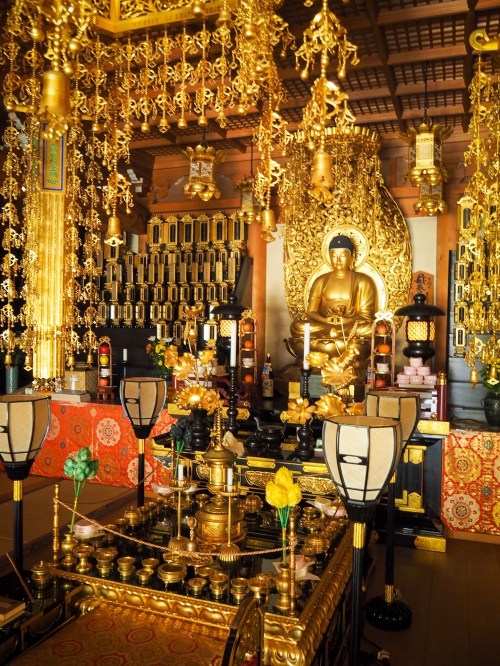Today’s leisurely walk would take us to through the agricultural heartland of Kochi Prefecture. We were on our way to Kochi City for two day’s rest in one of Shikoku’s larger urban centers. Along the way, we will visit three more temples on the Henro-michi.
First comes Dianichiji, Temple 28, a modest complex brought to life on this early April morning by a burst of cherry blossoms.
Our route meanders through water-laden fields as workers busily go about planting a new crop of rice. Abutting the rice fields are row upon row of plastic greenhouses. Onions appear to be the crop of choice right now and the their pungent aroma envelopes us. There’s evidence of other crops as well. Through open doors of small warehouses and garages we notice red peppers, eggplants and and cucumbers being sorted and crated.
A narrow thread of a road passing between rice paddies leads us to Temple 29, Kokubunji. This is the most atmospheric of the day’s temples. Founded in 739, the complex of old wood buildings surround a courtyard dominated by a carefully cultivated cherry tree. It’s willowy branches, supported by wooden poles, rise up and then arch back down to earth, illuminated with trails of delicate white blossoms.
Tomatoes. They are grown here too and we have been gorging on a particularly sweet and flavourful fruit tomato. Kochi Prefecture has many protected horticulture zones, places that are responsible for a large portion of Japan’s vegetable production. We are walking through the thick of this agricultural zone, rubbing shoulders with its field workers, passing along its narrow roads lined with greenhouses, taking in the scents of its produce. A unique experience indeed.
Temple 30, Zenrakuji, is the oddest of the day. The main temple building is a concrete and steel edifice. Traditional wood posts and beams, details and joinery have been reproduced in steel with a gold finish.
By late afternoon we have left the rural landscape, passed through urban fringes and made our way to the heart of Kochi City and our uber-urban hotel, the Seven Day’s Plus. The day ends at Hirome Market, a bustling collection of food and drink stalls. There is an amazing array of food available, matched only by the range of alcohol to be poured. Flames blaze wildly, lightly charring bonito fillets. Barely visible behind the stands papered with price lists and offerings, vendors offer beer by the mug and sake and shochi and so many other unfamiliar beverages. We nestle down on a bench between drinkers and smokers and settle in for our own feast of sushi and bonito, beer and sake. We should be tired. We should be sleeping. But the loud party at Hirome keeps us going.
After all, tomorrow is a rest day.
































